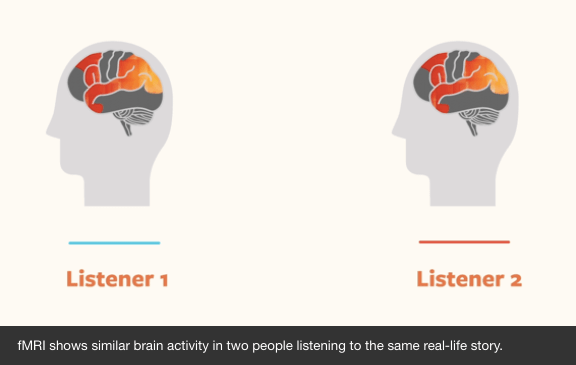
If you don’t think you’re a storyteller, we’ve got news for you. You are.
As humans, we tell stories all day long – and it’s more than just childhood fables we’re sharing.
Whether you’re an HR pro rolling out a new company initiative or an engineer sharing results of a recent project, storytelling is what gets your messages across.
In this article, we’ll explore the power of storytelling and how it can inspire action, connection, and higher performance within organizations.
The Science of Storytelling
Storytelling elicits an emotional response and connects people. Don’t just take our word for it, there’s research to back it up.
Neuroscientist Uri Hasson researches the neurological basis of human communication and storytelling, and in his TED talk, he breaks down how audiences show higher brain activity when listening to a story. In this way, a great story can allow two brains to sync up and align.

How Storytelling Shows Up at Work
The way teams communicate with each other has lasting impacts – it can either connect or fragment a company’s culture. It makes sense that effective communication stems from intentional storytelling.
According to the International Association of Business Communicators, storytelling within organizations can “build trust, support shared purpose, define and reinforce values, illustrate culture, and build employer and market brands.”
Here are a few examples of what storytelling may look like in a variety of different roles:
- Leaders can help employees understand and embrace the company’s core values and vision.
- HR professionals use stories to reinforce internal values and connect with employees in an authentic way.
- Marketing and storytelling go hand in hand. Marketers create stories that connect to the hearts and minds of their audiences.
- Engineers need to be able to articulate in technical and non-technical terms about the systems they operate. Engineer Bradley Shively says “the ability to effectively communicate makes it easier to work across teams, solve (or avoid) problems, and build the right systems and software.”
- Sales teams are constantly sharing stories with prospects as a way to communicate the value of what they’re pitching. Odds are you’ve likely received outreach from a sales rep who included a personalized video about how others have found success with the product or service.
- Customer success teams use stories to nurture and support clients – and relay feedback to internal stakeholders.
- Finance professionals do more than crunch numbers. Jeff Thomson, CEO of Institute of Management Accountants, says how people in finance roles have to be able to “effectively tell the story behind the numbers they report and the decisions they make.”
From communicating projects to connecting with peers, every single employee is a storyteller whether they realize it or not.
To best support your team and organizational goals, you have to consider how purposeful storytelling plays a critical role in building and sustaining a healthy company culture.
Create Your Internal Storytelling Strategy
People crave authenticity. No one wants to listen to a story that feels like corporate propaganda or fluff.
So, how can leaders model the way and empower their teams to share authentic stories?
Step 1: Measure Connection to Inform Stories
You have to understand how your team feels in order to learn what types of stories will resonate.
Benchmark how connected employees feel with their peers, manager, company, work, and self. You may find that teammates feel disconnected from company values. In that case, people may be inspired by a coworker who shares a story about how a core organizational value influenced their work.
Step 2: Help Teammates Tap Into Their Storytelling Skills
For many people, sharing stories can be awkward and anxiety-inducing. But, it doesn’t have to be that way.
Leaders have the opportunity to offer resources that can help their team identify and effectively communicate stories.
Here are three easy ways to get started…
- Watch Josh Campbell’s 9 minute TEDx talk about the “Seven Keys to Good Storytelling.” It’s a short video, but it’s jam-packed with tips that will get you thinking. Knowing how to avoid telling bad stories sets you up to tell great stories.
- Unlock your team’s creativity and confidence through a Breakthrough Play session with Gary Ware. Gary applies improvisation principles and other experiential techniques to boost team engagement and morale.
- Host a workshop with our Latch team of company culture and change management experts who can help make storytelling your organization’s competitive advantage.
Step 3: Make Purposeful Storytelling a Habit
Now it’s time to take things to the next level. To continue engaging people from across the organization, it’s important to dedicate space to invite conversation.
That’s why we built our Latch platform. Through Latch, organizations can share internal stories that spark open dialogue, align teams, and drive performance.
Storytelling through Latch is a catalyst for people feeling more connected to the work they do and the people they do it with.
When you combine Latch’s storytelling component with its real-time survey and guided reflection features, it’s a win for both leaders and employees.
- By sharing their own stories and hearing from others, employees feel seen, heard, and understood. The more emotionally connected teammates feel, the more the business as a whole will flourish.
- Leaders gain actionable data insights that highlight the current state of company culture. Additionally, executives score recommendations of how to increase connection and alignment across the organization.
Want to explore how Latch can eliminate misunderstanding and create meaningful connections for your team?








